DOG DAYS—DREARINESS, STIFLING HEAT, AND HOPE OF CHANGE
There are more pieces of folk wisdom, myths, superstitions, and the like associated with the so-called Dog Days of summer than there are yellow jackets in a thriving nest at the end of August. This folklore ranges widely—the linkage between katydid song and frost, warnings about “dew poisoning” in an open wound (usually on some barefooted youngster who had an unfortunate encounter with something like a piece or glass or sharp stone), fogs during the period as a prognosticator of how many snows there will be in winter, and myriad tidbits of folk information linking dire developments with Dog Days. It’s almost as if old Will Shakespeare should have added a footnote when he warned readers to “beware of the Ides of March” which suggested “take care in the Dog Days as well.”
Technically Dog Days begin in early July and continue into the first part of August, but in my mind and in the folklore I grew up with in the Smokies they were more closely associated with August and the beginning of September. This was a time when crops and already been “laid by” and most seasonal vegetables had “made.” Intense work in keeping weeds at bay, cultivating corn and other crops, and putting in plenty of work on the business end of a hoe handle or plow had given way to equally arduous efforts involving “putting up” what the good earth had produced. Merely thinking of Dog Days evokes memories of boyhood, and many of them are special. Here’s a sampling:
*Stringing green beans and either breaking them for canning or attaching them to long pieces of twine, with aid of a heavy-duty needle, to dry as leather britches.
*Canning peaches and making peach butter and peach preserves.
*Canning soup mix which might contain, among other things, tomatoes, lima beans, crowder peas, corn, and okra.
*Pulling, shucking, and silking a big picking of corn which was destined for canning or pickling.
*Working up tomatoes to can in quart jars. Come winter they might make the basis for vegetable or vegetable-beef soup, be used for a hot dish of scalloped tomatoes, served cold, or used in other fashions.
*Knocking down wasp nests or digging up those of yellow jackets for bait to use in the nearby river as I fished for bream, catfish, and knotty heads.
*Long jaunts by shank’s mare into the backcountry for a day of fly fishing for trout.
*Cornbread figuring prominently on the daily menu (see the recipe section below, all of which is devoted to “main dish” offerings featuring cornbread).
*Whiling away idle hours swimming in the creek.
*Enjoying watermelons and “mushmelons” (what Grandpa called cantaloupes) we had grown.
*Putting in the required sweat equity to make hand-churned, homemade ice cream and getting to lick the dasher because you had done the cranking.
*Picnics with the extended family.
*Actually looking forward to school classes resuming, although no red-blooded boy would have ever admitted as much out loud.
*Dreaming of the opening of squirrel season (today it’s thoughts of coming dove season and, even more significant, the arrival of another year’s deer hunting).
*Dealing with stifling heat, stings from packsaddles, stings from yellow jackets or wasps, and feeling like the humidity was so thick you could almost swim in it.
There’s more, much more, but even though most of the recollections just offered fall on the plus side of the scale, my overall assessment of the prevailing situation in yesteryear as well as today falls into the “this too shall pass away” category. Taken in its totality, I reckon August has to be my least liked month, although February comes in a close second. It’s more a month to endure than to enjoy, and being outside any time between around 9:00 a.m. and sunset translates to being soaking wet in short order along with finding precious little to like about the usually wonderful world of the outdoors.
RECENT READING
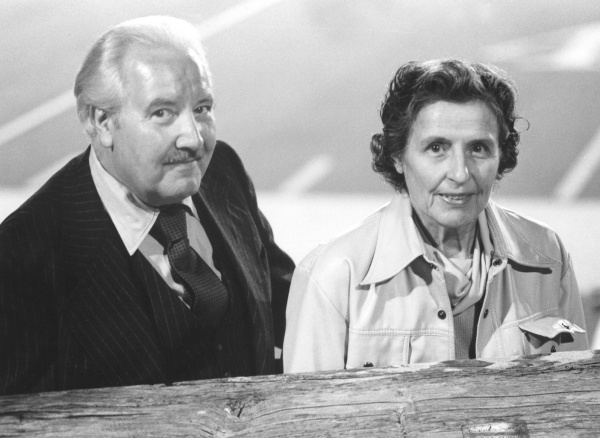
John and Dorothy Parris
One thing which is appealing in August, although for me that a situation which never changes, is getting comfortable with a good book and enjoying the unending pleasures of reading. I go through books like a dose of salts, and as anyone who has followed me for some time knows, my tastes range widely. Recently I’ve read a couple of books tracing the travels of Victorian adventurer Sir Richard Burton; Mary Lovell’s biography of Beryl Markham, the author of West with the Night; several of the ongoing series of light fishing mysteries by Victoria Houston graciously shared with me by a regular reader of this newsletter; and a couple of books on African hunting and adventure by W. R. Foran. I’ve also been rereading a lot of columns by one of my favorite writers, John Parris. He captured the nature of folkways in the Southern Appalachians wonderfully well and, along with his wife, Dorothy, endowed the chair in Appalachian Studies at Western Carolina University now held by the celebrated author Ron Rash.
LAUGHTER—THE BEST MEDICINE
Over time I’ve shared multiple moments of mirth provided by an individual, Britt McCracken, who unquestionably ranks as the funniest fellow I’ve ever known. He will be the subject of a chapter in the book I’m presently completing, “Profiles in Mountain Character.”
On one occasion Britt was part of a group camping on one of the streams running into the Fontana Lake’s north shore. At that time the campsite had a rough privy (a practice long since abandoned by the Great Smoky Mountains National Park) and after supper the group of campers had taken the easy but somewhat foolish expedient of dumping their scraps and leftovers, including the bones of a big mess of trout they had enjoyed, down the outhouse hole.
At some point well after dark when everyone was sitting around the convivial campfire telling tales and no doubt in some cases imbibing a bit of tanglefoot, one member of the party, a Bryson City businessman named Henry Truett, got up and headed for the john. At that juncture it’s best to pick up with the way Britt related matters. “He got settled down to business and was making good progress,” Britt said, “when the ground beneath him began to rumble and the toilet seat commenced to shaking like an earthquake was taking place.” It turns out a small bear, apparently attracted by the smell of the fish and other fried foods, had somehow clambered all the way down into the privy hole.
“I’ve seen sack races and three-legged races where folks managed to scramble along at a pretty good pace,” Britt related. “But let me tell you right now. You ain’t seen real speed in that sort of situation until you watch a guy with his pants around his ankles making tracks after a cheek to cheek encounter with a bear. How he kept from falling and half killing himself is a mystery to me, but I guarantee he set a new time record for a hobbled man fleeing a bear that had just been pooped on. It also instantly cured any hints of constipation he might have had.”
JIM’S DOIN’S
On the surface at least recent weeks might seem as if I’ve turned into a worthless blob doing little of anything meaningful. Let me assure you such is not the case, at least when it comes to work. My parents blessed me abundantly in many ways, and certainly one of them was a staunch work ethic. I fully understand what students of society sometimes describe as the “Protestant ethic,” because any time I tend towards being trifling or lazy a sense of guilt sets in. Conversely, with tasks accomplished—whether it is hoeing out the garden or wrapping up a magazine article—there comes a sense of inner satisfaction and well being.
Of late though, most of that involves longer term projects. I’m awaiting the proofs on two books, “Fishing for Chickens: A Smokies Food Memoir” (being published by the University of Georgia Press) and “Nimrods in Africa: The Pioneers” (to come from the publishing wing of Sporting Classics magazine). Once they come, that will likely mean a real blitz, because careful proofing is something which requires intense concentration. Meanwhile, I’ve finished all but six chapters (out of a total of thirty-six) of another manuscript. It is a collection of profiles of mountain characters, perhaps half of whom I knew and the others chosen because of being representative of specific traits or just having interesting personalities, who collectively epitomize high country folkways. A proposal for that work is currently out for consideration.
Beyond that, as I indicated would be the case in the July newsletter, I was actually in my beloved Smokies earlier this month for a presentation on A Smoky Mountain Boyhood and to attend a sort of unveiling or special announcement of the acquisition and digitization of the Dr. Kelly E. Bennett collection of photos by Western Carolina University. I’ve been involved in the process and when it is completed hundreds upon hundreds of grand images capturing so much of the face of the mountain past will be available on the Internet. My brother, Don, has done yeoman work in identifying places and people in the images, and others have been able to add to his findings in a fashion which enhances the value of the collection. The gathering of forty-plus people who attended that event was enthralled at the sampling of images they were shown, and I was likewise delighted with the turnout for my talk (including several of you who receive this newsletter). On the publication front, I have two pieces in the current (Aug./Sept.) edition of Smoky Mountain Living, my regular offering on food, “The Many Pleasures of Pickles,” on pages 13-17 and a feature article, “The Enduring Allure of Old Cabins,” on pages 42-49. In addition, my column, “Abel Chapman: Forgotten Hunting Writer and Conservationist,” is in the 2021 Archery, Guns, and Hunting issue of Sporting Classics, 2021, pages 143-46.
MAKIN’S FROM CORNBREAD
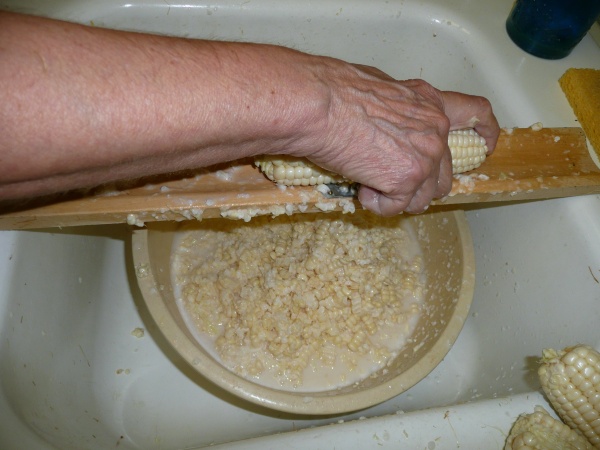
Corn in its many forms—roastin’ ears, stewed, fried, gritted, hominy, mush, grits, and in the endless ways corn meal can be prepared—was long a staff of life for mountain folks. Times without number, not just in the summer but throughout the year, cornbread was a central feature of meals in my boyhood home. Seldom did a day go by when Momma or Grandma Minnie (I spent a lot of time at her and Grandpa Joe’s home) didn’t bake a pone of cornbread. Both used a big cast-iron pan, seasoned so well the cooked pone slid out of it slick as a whistle when removed from the oven. We’d have it hot, slathered with butter, at dinner and often supper was leftover cold cornbread and milk. With sliced tomatoes, cucumbers, and maybe a piece of streaked meat fried to a crisp. Yet there were other ways of fixing cornbread which turned it into a full meal that went well beyond a simple pone. Here are some examples.
TRADITIONAL CORNBREAD
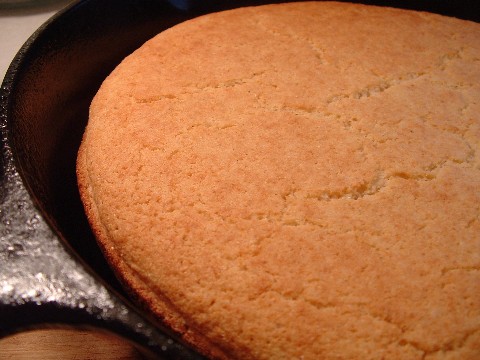
I don’t know that any two fine mountain cooks approach making cornbread in exactly the same fashion. So much is that the case that I’m even reluctant to provide a recipe, although in my approach there are certain “musts.” You must use eggs, your cornmeal must be stone ground, buttermilk is a must, and nothing works without a well-seasoned cast iron pan which is pre-heated before you pour in your batter. Beyond that, here are a few thoughts along with active encouragement to experiment until you get the recipe you like best.
*Meat grease makes for better taste than store-bought oil (save your bacon grease!).
*Mountain wisdom always held that yellow corn was for critters and meal from white corn or humans, but I actually like yellow cornmeal better.
*As one of the recipes below suggests, a pone of cornmeal can be given all sorts of added appeal through infusion of ingredients beyond those for the actual pone.
*If you don’t like the texture of regular cornmeal, sift your meal before preparing the cornbread. That’s not for me but some folks don’t care for the grainy “crunch” of regular meal.
CORNBREAD SALAD
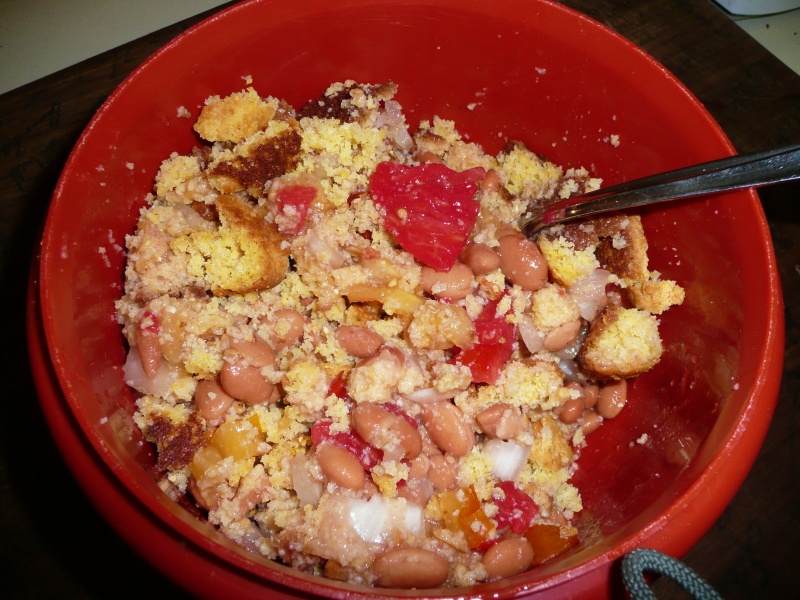
A grand way to use cornbread in the summer, especially when it is left over, is cornbread salad. It’s the essence of simplicity. Just crumble up an ample amount of cornbread for an individual portion, or if you are serving several may a half pone or more, then chop up and add whatever fresh garden vegetables you have available at the time. My favorites are tomatoes, cucumbers, onion, squash, and zucchini. Green pepper is also good but unfortunately my stomach doesn’t gee-haw with it any more. However, I can tolerate a bit of hot pepper so that sometimes gets added as well. Dress it up with a bit of mayonnaise, some thick buttermilk, or ranch dressing, stir everything together, and dig in. Incidentally, it keeps well in the refrigerator and is, if anything, better left over.
CORNBREAD AND HAMBURGER GRAVY
Meat was something of a luxury in my boyhood home, although I really didn’t realize it at the time. We ate far more pork than anything else, with chicken being reserved for Sunday. In season we enjoyed pretty regular meals of fish or wild game, but beef was a special treat. Rarely there would be a splurge for a roast, but far more common was the use of ground beef. One way Momma utilized it to frugal, tasty advantage was to make hamburger gravy and combine it with a pone of cornbread. The gravy was just plain milk gravy made with the cheapest grade of burger (that meant it had plenty of fat in it), possibly sausage instead of hamburger, or on occasion even bacon grease with bits of bacon crumbled in the gravy. Whatever the meat base, there was always lots of flour to expand the amount. Poured over cornbread crumbled up in a bowl it was tasty, filling, and when buttressed by canned vegetables such as green beans, along with a side serving of apples, made for a full and enjoyable meal.
Incidentally, true, original sawmill gravy does not use flour, and I don’t care what Cracker Barrel fans say to the contrary. It uses corn meal as the thickening agent and is made with milk, sausage or bacon grease (and sometimes, though not always, meat), and salt and pepper. The name came from the lumbering operations where it was once served. Corn meal was cheap, the gravy thick and hearty, and it was an ideal way to make a little bit of meat or meat flavor go a long way. Try making genuine sawmill gravy sometime using corn meal (sift it if you don’t like the grittiness of corn, although I for one do). You might be most pleasantly surprised, and it’s mighty tasty atop yes—cornbread. In effect you get a cornmeal-based gravy in combination with cornbread.
MEATY MEXICAN CORNBREAD
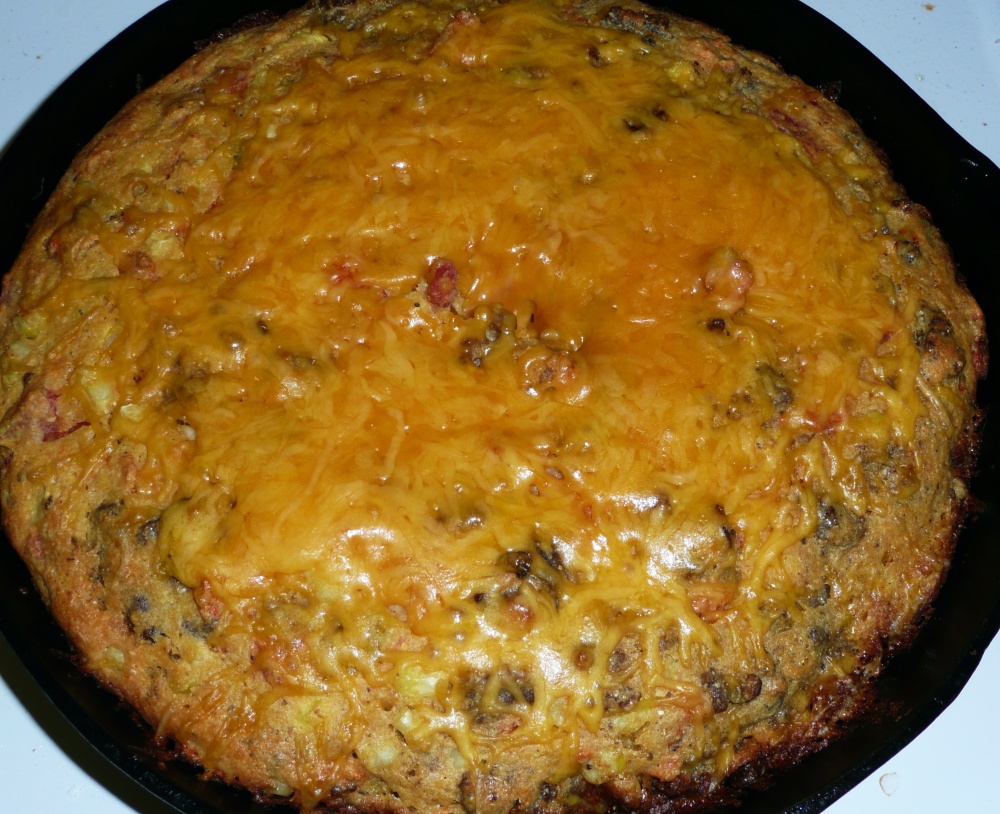
In her later years my Great Aunt Lillie Casada lived in a cluster of apartments close to my boyhood home. Likely lonely and certainly curious, she often showed up at my parents’ home whenever I returned to the mountains for a visit. She was a congenial soul for whom work had been a lifelong companion, and she was also a splendid cook. In typical mountain fashion she never, ever showed up at the door for a visit without bringing a little gift of some kind with her. More often than not it was food, and one of her favorites was what she called Mexican cornbread. It was just traditional cornbread given a good bit of pizzazz through the addition of flakes of dried chili peppers or maybe some jalapenos chopped up and included in the batter.
This recipe is, in a sense, an expansion of that Mexican cornbread, and since it combines meat, corn meal, tomatoes, and peppers, it serves quite nicely as a full meal. Leftover portions of the “pie” reheat quite nicely, and it’s something which will certainly stick to your ribs no matter how peckish you might be.
Prepare the batter for cornbread as you normally do with the exception of whatever amount of cooking oil or lard you add.
Add one can of Ro-Tel (tomatoes with diced green chili peppers) or fresh tomatoes and chilies.
Brown a half pound of 80% lean hamburger and add meat as well as grease to the batter.
Slice the kernels from one large or two small ears of corn.
Mix the latter ingredients into your batter and add to a pre-heated cast iron skillet in a 450-degree oven. Bake until done (will require longer than your regular cornbread), remove from oven, and sprinkle liberally with grated extra sharp cheese. Put back in oven just long enough (60 to 90 seconds) to melt the cheese.
Remove and slide onto a plate to serve. Hearty and mighty tasty.
CORN PONE PIE
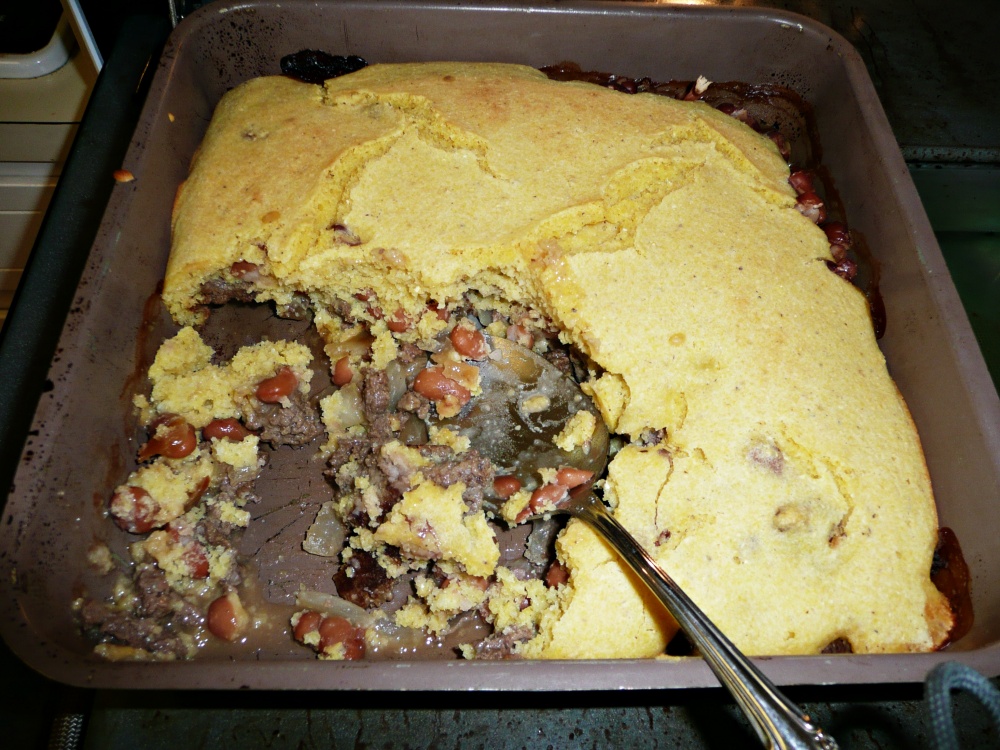
This recipe is really just an alternate approach, with several different ingredients, to the preceding offering. Once again, begin with your regular recipe for cornbread (leave out the cooking oil) and prepare the batter.
Brown a half pound of 80% lean burger in a pan along with a sliced sweet onion.
When browned, empty a can of pinto beans into the batter, add the meat-and-onion mix, and bake in a baking dish or well-greased cast-iron skillet at 400 degrees until done.
Serve with slaw, a green salad, or some type of fruit for a full meal.